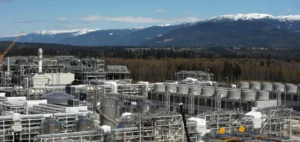Wholesale electricity prices in the western United States are experiencing a significant increase in response to a record-breaking heat wave forecast across the Southwest and Southern California. This situation has led to the issuance of excessive heat warnings by the United States National Weather Service (NWS) in its October 1st forecast discussion.
The expected high temperatures are caused by an upper-level ridge over the Four Corners region, creating extreme thermal conditions with highs ranging from 35 to 43 degrees Celsius. Minimum temperatures will also remain high, offering little overnight relief. According to CustomWeather data, the population-weighted average daily temperature is forecasted to reach 23.3 degrees Celsius on October 2nd across the California Independent System Operator (CAISO) footprint, significantly exceeding the historical average of nearly 15.5 degrees Celsius for October.
The California Independent System Operator (CAISO) forecasts peak load to reach 41.462 gigawatts on October 2nd, a 28% increase from the prior seven-day average. This forecast is significantly higher than the average peak load of 29.684 gigawatts recorded in October 2023. CAISO spokesperson Anne Gonzales told S&P Global Commodity Insights on October 1st that no flex alerts have been issued or are planned, noting that CAISO has not issued a flex alert since 2022. CAISO’s all-time peak load is 52.061 gigawatts, reached on September 6, 2022.
Demand management
“The CAISO is closely monitoring the rise in temperatures this week,” said Gonzales. “The CAISO continues to forecast sufficient energy to cover demand through this week and does not anticipate any supply shortfalls.” Additionally, no wildfire activity is currently threatening assets, she added.
The rising temperatures and demand forecasts have driven wholesale electricity prices upward. On the Intercontinental Exchange (ICE), Palo Verde on-peak day-ahead traded around $68 per megawatt-hour (MWh) for October 2nd delivery, a nearly 40% jump from the prior seven-day average, according to data from Platts, a division of S&P Global Commodity Insights. Likewise, Mead on-peak day-ahead traded around $72.75 per MWh on ICE, 47.5% higher than the prior seven-day average.
Gas demand and price rise
Additionally, SP15 on-peak day-ahead traded around $54.25 per MWh for October 2nd delivery on the Intercontinental Exchange, nearly 62% above the prior seven-day average, according to CAISO data. The on-peak balance of the week package was bid at $47 per MWh and offered at $50 per MWh on ICE.
Total gas consumption in the state reached 5.6 billion cubic feet per day (Bcf/d) on October 1st, up from 4.8 Bcf/d in the previous seven days, the highest level since September 9th, according to Commodity Insights data. The spot gas price at PG&E city-gates rose to $4.65 per million British thermal units (MMBtu) for October 1st flows, its highest point since mid-January, according to Platts data. It eased to $4.10 per MMBtu for October 2nd flows, but was still well above the average price of $3 per MMBtu for flows in the seven days prior to September 30th.
The SoCalGas city-gate price similarly hit an eight-month high of $3.42 per MMBtu for October 1st flows and rose further to $3.72 per MMBtu for gas flowing on October 2nd, Platts data showed. It had averaged $2.55 per MMBtu in the week to September 29th.
Impact on the energy market
This increase in natural gas demand reflects the heightened need for power generation to meet the elevated energy demand caused by the heat wave. Grid operators like CAISO are closely monitoring the balance between supply and demand to prevent any supply shortages. The absence of flex alerts indicates confidence in the system’s ability to meet the increased demand.
High natural gas prices directly influence electricity production costs, especially in gas-fired power plants, contributing to the overall rise in wholesale electricity prices. This situation highlights the energy market’s vulnerability to extreme weather conditions and underscores the importance of effective resource management to maintain price stability and supply.
Outlook and measures taken
In response to these challenges, operators and regulators are seeking to optimize demand management and enhance grid resilience. Initiatives to improve energy efficiency and diversify renewable energy sources can help mitigate the impacts of future heat waves. Continuous monitoring of weather conditions and consumption trends is crucial for anticipating and responding effectively to energy demand fluctuations.





















